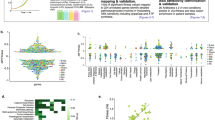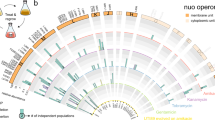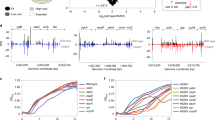Abstract
Antibiotic resistance is an increasingly serious public health threat1. Understanding pathways allowing bacteria to survive antibiotic stress may unveil new therapeutic targets2,3,4,5,6,7,8. We explore the role of the bacterial epigenome in antibiotic stress survival using classical genetic tools and single-molecule real-time sequencing to characterize genomic methylation kinetics. We find that Escherichia coli survival under antibiotic pressure is severely compromised without adenine methylation at GATC sites. Although the adenine methylome remains stable during drug stress, without GATC methylation, methyl-dependent mismatch repair (MMR) is deleterious and, fueled by the drug-induced error-prone polymerase Pol IV, overwhelms cells with toxic DNA breaks. In multiple E. coli strains, including pathogenic and drug-resistant clinical isolates, DNA adenine methyltransferase deficiency potentiates antibiotics from the β-lactam and quinolone classes. This work indicates that the GATC methylome provides structural support for bacterial survival during antibiotic stress and suggests targeting bacterial DNA methylation as a viable approach to enhancing antibiotic activity.
This is a preview of subscription content, access via your institution
Access options
Subscribe to this journal
Receive 12 print issues and online access
$209.00 per year
only $17.42 per issue
Buy this article
- Purchase on Springer Link
- Instant access to full article PDF
Prices may be subject to local taxes which are calculated during checkout




Similar content being viewed by others
Accession codes
References
World Health Organization. Antimicrobial Resistance: Global Surveillance Report (World Health Organization, 2014).
Lee, S. et al. Targeting a bacterial stress response to enhance antibiotic action. Proc. Natl. Acad. Sci. USA 106, 14570–14575 (2009).
Lu, T.K. & Collins, J.J. Engineered bacteriophage targeting gene networks as adjuvants for antibiotic therapy. Proc. Natl. Acad. Sci. USA 106, 4629–4634 (2009).
Wigle, T.J. et al. Inhibitors of RecA activity discovered by high-throughput screening: cell-permeable small molecules attenuate the SOS response in Escherichia coli. J. Biomol. Screen. 14, 1092–1101 (2009).
Brynildsen, M.P., Winkler, J.A., Spina, C.S., MacDonald, I.C. & Collins, J.J. Potentiating antibacterial activity by predictably enhancing endogenous microbial ROS production. Nat. Biotechnol. 31, 160–165 (2013).
Poole, K. Bacterial stress responses as determinants of antimicrobial resistance. J. Antimicrob. Chemother. 67, 2069–2089 (2012).
Wexselblatt, E. et al. Relacin, a novel antibacterial agent targeting the stringent response. PLoS Pathog. 8, e1002925 (2012).
Grant, S.S., Kaufmann, B.B., Chand, N.S., Haseley, N. & Hung, D.T. Eradication of bacterial persisters with antibiotic-generated hydroxyl radicals. Proc. Natl. Acad. Sci. USA 109, 12147–12152 (2012).
Miller, C. et al. SOS response induction by β-lactams and bacterial defense against antibiotic lethality. Science 305, 1629–1631 (2004).
Shaw, K.J. et al. Comparison of the changes in global gene expression of Escherichia coli induced by four bactericidal agents. J. Mol. Microbiol. Biotechnol. 5, 105–122 (2003).
Kaldalu, N., Mei, R. & Lewis, K. Killing by ampicillin and ofloxacin induces overlapping changes in Escherichia coli transcription profile. Antimicrob. Agents Chemother. 48, 890–896 (2004).
Goh, E.B. et al. Transcriptional modulation of bacterial gene expression by subinhibitory concentrations of antibiotics. Proc. Natl. Acad. Sci. USA 99, 17025–17030 (2002).
Mesak, L.R., Miao, V. & Davies, J. Effects of subinhibitory concentrations of antibiotics on SOS and DNA repair gene expression in Staphylococcus aureus. Antimicrob. Agents Chemother. 52, 3394–3397 (2008).
Laureti, L., Matic, I. & Gutierrez, A. Bacterial responses and genome instability induced by subinhibitory concentrations of antibiotics. Antibiotics (Basel) 2, 100–114 (2013).
Poole, K. Stress responses as determinants of antimicrobial resistance in Gram-negative bacteria. Trends Microbiol. 20, 227–234 (2012).
Sexton, J.Z. et al. Novel inhibitors of E. coli RecA ATPase activity. Curr. Chem. Genomics 4, 34–42 (2010).
Dwyer, D.J. et al. Antibiotics induce redox-related physiological alterations as part of their lethality. Proc. Natl. Acad. Sci. USA 111, E2100–E2109 (2014).
Kohanski, M.A., Dwyer, D.J., Hayete, B., Lawrence, C.A. & Collins, J.J. A common mechanism of cellular death induced by bactericidal antibiotics. Cell 130, 797–810 (2007).
Kültz, D. Evolution of the cellular stress proteome: from monophyletic origin to ubiquitous function. J. Exp. Biol. 206, 3119–3124 (2003).
Schroeder, E.A., Raimundo, N. & Shadel, G.S. Epigenetic silencing mediates mitochondria stress-induced longevity. Cell Metab. 17, 954–964 (2013).
Chinnusamy, V. & Zhu, J.K. Epigenetic regulation of stress responses in plants. Curr. Opin. Plant Biol. 12, 133–139 (2009).
Weaver, I.C. et al. Epigenetic programming by maternal behavior. Nat. Neurosci. 7, 847–854 (2004).
Provençal, N., Booij, L. & Tremblay, R.E. The developmental origins of chronic physical aggression: biological pathways triggered by early life adversity. J. Exp. Biol. 218, 123–133 (2015).
Casadesús, J. & Low, D. Epigenetic gene regulation in the bacterial world. Microbiol. Mol. Biol. Rev. 70, 830–856 (2006).
Marinus, M.G. & Casadesus, J. Roles of DNA adenine methylation in host-pathogen interactions: mismatch repair, transcriptional regulation, and more. FEMS Microbiol. Rev. 33, 488–503 (2009).
Vasu, K. & Nagaraja, V. Diverse functions of restriction-modification systems in addition to cellular defense. Microbiol. Mol. Biol. Rev. 77, 53–72 (2013).
Casadesús, J. & Low, D.A. Programmed heterogeneity: epigenetic mechanisms in bacteria. J. Biol. Chem. 288, 13929–13935 (2013).
Srikhanta, Y.N. et al. Phasevarions mediate random switching of gene expression in pathogenic Neisseria. PLoS Pathog. 5, e1000400 (2009).
Camacho, E.M. & Casadesús, J. Regulation of traJ transcription in the Salmonella virulence plasmid by strand-specific DNA adenine hemimethylation. Mol. Microbiol. 57, 1700–1718 (2005).
Camacho, E.M. et al. Regulation of finP transcription by DNA adenine methylation in the virulence plasmid of Salmonella enterica. J. Bacteriol. 187, 5691–5699 (2005).
Brunet, Y.R., Bernard, C.S., Gavioli, M., Lloubès, R. & Cascales, E. An epigenetic switch involving overlapping Fur and DNA methylation optimizes expression of a type VI secretion gene cluster. PLoS Genet. 7, e1002205 (2011).
Hernday, A.D., Braaten, B.A. & Low, D.A. The mechanism by which DNA adenine methylase and PapI activate the Pap epigenetic switch. Mol. Cell 12, 947–957 (2003).
Davis, B.M., Chao, M.C. & Waldor, M.K. Entering the era of bacterial epigenomics with single molecule real time DNA sequencing. Curr. Opin. Microbiol. 16, 192–198 (2013).
Fang, G. et al. Genome-wide mapping of methylated adenine residues in pathogenic Escherichia coli using single-molecule real-time sequencing. Nat. Biotechnol. 30, 1232–1239 (2012).
Flusberg, B.A. et al. Direct detection of DNA methylation during single-molecule, real-time sequencing. Nat. Methods 7, 461–465 (2010).
Blow, M.J. et al. The epigenomic landscape of prokaryotes. PLoS Genet. 12, e1005854 (2016).
Horton, J.R., Zhang, X., Blumenthal, R.M. & Cheng, X. Structures of Escherichia coli DNA adenine methyltransferase (Dam) in complex with a non-GATC sequence: potential implications for methylation-independent transcriptional repression. Nucleic Acids Res. 43, 4296–4308 (2015).
Guyot, J.B., Grassi, J., Hahn, U. & Guschlbauer, W. The role of the preserved sequences of Dam methylase. Nucleic Acids Res. 21, 3183–3190 (1993).
Schadt, E.E. et al. Modeling kinetic rate variation in third generation DNA sequencing data to detect putative modifications to DNA bases. Genome Res. 23, 129–141 (2013).
Urig, S. et al. The Escherichia coli Dam DNA methyltransferase modifies DNA in a highly processive reaction. J. Mol. Biol. 319, 1085–1096 (2002).
Tavazoie, S. & Church, G.M. Quantitative whole-genome analysis of DNA-protein interactions by in vivo methylase protection in E. coli. Nat. Biotechnol. 16, 566–571 (1998).
Wang, M.X. & Church, G.M. A whole genome approach to in vivo DNA-protein interactions in E. coli. Nature 360, 606–610 (1992).
Holst, B., Søgaard-Andersen, L., Pedersen, H. & Valentin-Hansen, P. The cAMP-CRP/CytR nucleoprotein complex in Escherichia coli: two pairs of closely linked binding sites for the cAMP-CRP activator complex are involved in combinatorial regulation of the cdd promoter. EMBO J. 11, 3635–3643 (1992).
Hale, W.B., van der Woude, M.W. & Low, D.A. Analysis of nonmethylated GATC sites in the Escherichia coli chromosome and identification of sites that are differentially methylated in response to environmental stimuli. J. Bacteriol. 176, 3438–3441 (1994).
Løbner-Olesen, A., Skovgaard, O. & Marinus, M.G. Dam methylation: coordinating cellular processes. Curr. Opin. Microbiol. 8, 154–160 (2005).
Kunkel, T.A. & Erie, D.A. DNA mismatch repair. Annu. Rev. Biochem. 74, 681–710 (2005).
Doutriaux, M.P., Wagner, R. & Radman, M. Mismatch-stimulated killing. Proc. Natl. Acad. Sci. USA 83, 2576–2578 (1986).
Marinus, M.G. Recombination is essential for viability of an Escherichia coli dam (DNA adenine methyltransferase) mutant. J. Bacteriol. 182, 463–468 (2000).
Fram, R.J., Cusick, P.S., Wilson, J.M. & Marinus, M.G. Mismatch repair of cis-diamminedichloroplatinum(II)-induced DNA damage. Mol. Pharmacol. 28, 51–55 (1985).
Karran, P. & Marinus, M.G. Mismatch correction at O6-methylguanine residues in E. coli DNA. Nature 296, 868–869 (1982).
Marinus, M.G. DNA methylation and mutator genes in Escherichia coli K-12. Mutat. Res. 705, 71–76 (2010).
Fijalkowska, I.J., Schaaper, R.M. & Jonczyk, P. DNA replication fidelity in Escherichia coli: a multi-DNA polymerase affair. FEMS Microbiol. Rev. 36, 1105–1121 (2012).
Galhardo, R.S., Hastings, P.J. & Rosenberg, S.M. Mutation as a stress response and the regulation of evolvability. Crit. Rev. Biochem. Mol. Biol. 42, 399–435 (2007).
Pérez-Capilla, T. et al. SOS-independent induction of dinB transcription by β-lactam–mediated inhibition of cell wall synthesis in Escherichia coli. J. Bacteriol. 187, 1515–1518 (2005).
Gutierrez, A. et al. β-Lactam antibiotics promote bacterial mutagenesis via an RpoS-mediated reduction in replication fidelity. Nat. Commun. 4, 1610 (2013).
Rohwer, F. & Azam, F. Detection of DNA damage in prokaryotes by terminal deoxyribonucleotide transferase–mediated dUTP nick end labeling. Appl. Environ. Microbiol. 66, 1001–1006 (2000).
McKelvie, J.C. et al. Inhibition of Yersinia pestis DNA adenine methyltransferase in vitro by a stibonic acid compound: identification of a potential novel class of antimicrobial agents. Br. J. Pharmacol. 168, 172–188 (2013).
Hobley, G. et al. Development of rationally designed DNA N6 adenine methyltransferase inhibitors. Bioorg. Med. Chem. Lett. 22, 3079–3082 (2012).
Mashhoon, N., Pruss, C., Carroll, M., Johnson, P.H. & Reich, N.O. Selective inhibitors of bacterial DNA adenine methyltransferases. J. Biomol. Screen. 11, 497–510 (2006).
Kohanski, M.A., DePristo, M.A. & Collins, J.J. Sublethal antibiotic treatment leads to multidrug resistance via radical-induced mutagenesis. Mol. Cell 37, 311–320 (2010).
Baharoglu, Z. & Mazel, D. Vibrio cholerae triggers SOS and mutagenesis in response to a wide range of antibiotics: a route towards multiresistance. Antimicrob. Agents Chemother. 55, 2438–2441 (2011).
Ysern, P. et al. Induction of SOS genes in Escherichia coli and mutagenesis in Salmonella typhimurium by fluoroquinolones. Mutagenesis 5, 63–66 (1990).
Chen, S.L. et al. Identification of genes subject to positive selection in uropathogenic strains of Escherichia coli: a comparative genomics approach. Proc. Natl. Acad. Sci. USA 103, 5977–5982 (2006).
Marino Sabo, E. & Stern, J.J. Approach to antimicrobial prophylaxis for urology procedures in the era of increasing fluoroquinolone resistance. Ann. Pharmacother. 48, 380–386 (2014).
Prieto, A.I., Ramos-Morales, F. & Casadesús, J. Bile-induced DNA damage in Salmonella enterica. Genetics 168, 1787–1794 (2004).
Peterson, K.R., Wertman, K.F., Mount, D.W. & Marinus, M.G. Viability of Escherichia coli K-12 DNA adenine methylase (dam) mutants requires increased expression of specific genes in the SOS regulon. Mol. Gen. Genet. 201, 14–19 (1985).
Courcelle, J., Khodursky, A., Peter, B., Brown, P.O. & Hanawalt, P.C. Comparative gene expression profiles following UV exposure in wild-type and SOS-deficient Escherichia coli. Genetics 158, 41–64 (2001).
Galhardo, R.S. et al. DinB upregulation is the sole role of the SOS response in stress-induced mutagenesis in Escherichia coli. Genetics 182, 55–68 (2009).
Tippin, B., Pham, P. & Goodman, M.F. Error-prone replication for better or worse. Trends Microbiol. 12, 288–295 (2004).
Wyrzykowski, J. & Volkert, M.R. The Escherichia coli methyl-directed mismatch repair system repairs base pairs containing oxidative lesions. J. Bacteriol. 185, 1701–1704 (2003).
Bale, A., d'Alarcao, M. & Marinus, M.G. Characterization of DNA adenine methylation mutants of Escherichia coli K12. Mutat. Res. 59, 157–165 (1979).
Heithoff, D.M., Sinsheimer, R.L., Low, D.A. & Mahan, M.J. An essential role for DNA adenine methylation in bacterial virulence. Science 284, 967–970 (1999).
Pucciarelli, M.G., Prieto, A.I., Casadesús, J. & García-del Portillo, F. Envelope instability in DNA adenine methylase mutants of Salmonella enterica. Microbiology 148, 1171–1182 (2002).
García-Del Portillo, F., Pucciarelli, M.G. & Casadesús, J. DNA adenine methylase mutants of Salmonella typhimurium show defects in protein secretion, cell invasion, and M cell cytotoxicity. Proc. Natl. Acad. Sci. USA 96, 11578–11583 (1999).
Murphy, K.C., Ritchie, J.M., Waldor, M.K., Løbner-Olesen, A. & Marinus, M.G. Dam methyltransferase is required for stable lysogeny of the Shiga toxin (Stx2)-encoding bacteriophage 933W of enterohemorrhagic Escherichia coli O157:H7. J. Bacteriol. 190, 438–441 (2008).
Baym, M. et al. Inexpensive multiplexed library preparation for megabase-sized genomes. PLoS One 10, e0128036 (2015).
Barrick, J.E. et al. Identifying structura l variation in haploid microbial genomes from short-read resequencing data using breseq. BMC Genomics 15, 1039 (2014).
Acknowledgements
We thank T. Ferrante, E. Cameron, K. Allison, J. Winkler, J. Way, C. Gruber, P. Bhargava, M. Painter, N. Sherpa, T. Lieberman, L. Certain and Y. Furuta for critical feedback and technical support over the course of this study. We also thank M. Conover and S. Hultgren (Washington University School of Medicine in St. Louis) for generously providing the UTI89 strain, as well as related reagents and protocols. Additionally, we are grateful for SMRT sequencing support from M. Zapp and E. Kittler at the University of Massachusetts Medical School Sequencing Core and from S. Mark, K. Luong, M. Weiand and O. Banerjee at Pacific Biosciences. This work was supported by funding from Defense Threat Reduction Agency grant HDTRA1-15-1-0051, US National Institutes of Health grant 1U54GM114838-01, the Mayo Clinic Center for Individualized Medicine and Donors Cure Foundation, the Howard Hughes Medical Institute, the Banting Postdoctoral Fellowship from the Canadian Institutes of Health and Research, and the Wyss Institute for Biologically Inspired Engineering, Harvard University.
Author information
Authors and Affiliations
Contributions
N.R.C. conceived of the project, designed and performed experiments, and wrote the manuscript. C.A.R. performed bioinformatics analyses. S.J. performed experiments. R.S.S. performed experiments and bioinformatics analyses. A.G. contributed intellectually to the project and helped design experiments. P.B. contributed intellectually to the project. H.L. performed bioinformatics analyses and provided mentorship. J.J.C. oversaw the project and provided mentorship.
Corresponding author
Ethics declarations
Competing interests
The authors declare no competing financial interests.
Integrated supplementary information
Supplementary Figure 1 Susceptibility of MTase-deficient E. coli K12 to sublethal ampicillin treatment.
(a,b) Wild-type (wt) or MTase-deficient E. coli BW25113 (a) or MG1655 (b) were grown in LB to an OD of 0.3 and then treated with ampicillin (2.5 μg/ml) or left untreated. CFUs and/or OD were monitored hourly. (c) Determination of ampicillin MIC (left) and MBC90 (right) for E. coli BW25113 by broth microdilution in LB. Wild-type and Δdam MIC values were 6 μg/ml and 4 μg/ml, respectively; wild-type and Δdam MBC90 values were 2.7 μg/ml and 1.5 μg/ml, respectively. Dotted lines indicate cutoff values for MIC (OD < 0.1) or MBC90 (10% survival). MBC90 values were interpolated using a sigmoidal curve fit model as shown. In a–c, data are shown as means ± s.e.m. of n = 2–3 independent experiments.
Supplementary Figure 2 Complementation of Δdam E. coli ampicillin sensitivity with wild-type or catalytically inactive mutant Dam.
Wild-type or Δdam E. coli BW25113 were transformed with the indicated Cmr plasmid expressing gfp, dam or mutant dam in which the catalytic DPPY motif is disrupted by a single amino acid change (D181S, D181N or P183R). Plasmid-bearing strains were grown in LB supplemented with chloramphenicol (15 μg/ml). (a) Genomic DNA extracted from the indicated strains at stationary phase was either digested with DpnII, which cleaves at GATC sites only in the absence of methylation, or left undigested. Digests were run on a 0.8% agarose gel containing ethidium bromide. (b) OD kinetics of wild-type or Δdam E. coli BW25113 harboring the indicated Cmr plasmids cultured in LB supplemented with chloramphenicol (15 μg/ml) with or without ampicillin (2.5 μg/ml) at log phase. (c) The indicated E. coli BW25113 strains were grown in LB to an OD of 0.2 and then treated with 2 μg/ml ampicillin or left untreated. In b and c, CFUs and/or OD were monitored hourly to assess survival. Data are shown as means ± s.e.m. of n = 3 independent experiments.
Supplementary Figure 3 Stability of GATC methylome kinetics during growth in the presence or absence of ampicillin.
Genome-wide GATC methylation kinetics displayed as in Figure 2d during growth in LB (top) or in LB supplemented with 2.5 μg/ml ampicillin (bottom). The top panel is the same as the plot displayed in Figure 2d. The empty green arrowhead highlights the only GATC site displaying statistically significant differential methylation between untreated and ampicillin-treated samples (Supplementary Table 2 and Supplementary Data Set 1).
Supplementary Figure 4 dinB, mutS and mutH dependence of Δdam E. coli sensitivity to ampicillin.
The indicated E. coli BW25113 strains were grown in LB to an OD of 0.3 and then treated with 2.5 μg/ml of ampicillin or left untreated. OD was monitored hourly to assess survival. Data are shown as means ± s.e.m. of n = 2 independent experiments.
Supplementary Figure 5 dinB, mutS and mutH dependence of Δdam sensitivity to ofloxacin.
The indicated E. coli BW25113 strains were grown in LB to an OD of 0.3 and then treated with ofloxacin (50 ng/ml) or left untreated. CFUs in bacterial cultures were monitored hourly to assess survival. Data are shown as mean percent survival ± s.e.m. of n = 2 independent experiments.
Supplementary information
Supplementary Text and Figures
Supplementary Figures 1–5 and Supplementary Tables 1–3. (PDF 2670 kb)
Supplementary Data Set 1
Raw methylation data and statistical analyses. (XLSX 10603 kb)
Supplementary Data Set 2
SMRT sequence coverage. (XLSX 6317 kb)
Rights and permissions
About this article
Cite this article
Cohen, N., Ross, C., Jain, S. et al. A role for the bacterial GATC methylome in antibiotic stress survival. Nat Genet 48, 581–586 (2016). https://doi.org/10.1038/ng.3530
Received:
Accepted:
Published:
Issue Date:
DOI: https://doi.org/10.1038/ng.3530
This article is cited by
-
Examining horizontal gene transfer in microbial communities
Nature Reviews Microbiology (2021)
-
Genome-wide methylome analysis of two strains belonging to the hypervirulent Neisseria meningitidis serogroup W ST-11 clonal complex
Scientific Reports (2021)
-
The bacterial epigenome
Nature Reviews Microbiology (2020)
-
Quantitative proteomic reveals gallium maltolate induces an iron-limited stress response and reduced quorum-sensing in Pseudomonas aeruginosa
JBIC Journal of Biological Inorganic Chemistry (2020)
-
NanoMod: a computational tool to detect DNA modifications using Nanopore long-read sequencing data
BMC Genomics (2019)



